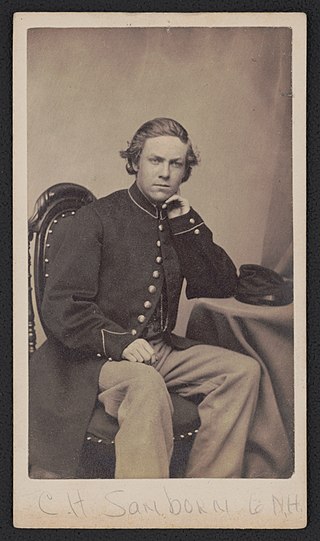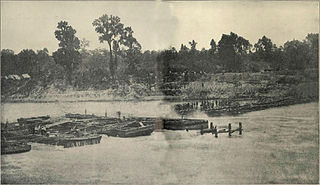
United States Colored Troops (USCT) were Union Army regiments during the American Civil War that primarily comprised African Americans, with soldiers from other ethnic groups also serving in USCT units. Established in response to a demand for more units from Union Army commanders, USCT regiments, which numbered 175 in total by the end of the war in 1865, constituted about one-tenth of the manpower of the army, according to historian Kelly Mezurek, author of For Their Own Cause: The 27th United States Colored Troops. "They served in infantry, artillery, and cavalry." Approximately 20 percent of USCT soldiers were killed in action or died of disease and other causes, a rate about 35 percent higher than that of white Union troops. Numerous USCT soldiers fought with distinction, with 16 receiving the Medal of Honor. The USCT regiments were precursors to the Buffalo Soldier units which fought in the American Indian Wars.

The 28th United States Colored Infantry, also called the 28th Indiana Infantry (Colored),1 was an African American infantry regiment from the state of Indiana that fought in the American Civil War.

}}

The 6th New Hampshire Infantry Regiment was an infantry regiment that served in the Union Army during the American Civil War.
The 11th United States Colored Infantry was an infantry regiment that served in the Union Army during the American Civil War. The regiment was composed of African American enlisted men commanded by white officers and was authorized by the Bureau of Colored Troops which was created by the United States War Department on May 22, 1863.
The 7th United States Colored Infantry was an infantry regiment that served in the Union Army during the American Civil War. The regiment was composed of African American enlisted men commanded by white officers and was authorized by the Bureau of Colored Troops which was created by the United States War Department on May 22, 1863.
The 8th United States Colored Infantry was an infantry regiment that served in the Union Army during the American Civil War. The regiment was composed of African American enlisted men commanded by white officers and was authorized by the Bureau of Colored Troops which was created by the United States War Department on May 22, 1863.
The 9th United States Colored Infantry was an infantry regiment that served in the Union Army during the American Civil War. The regiment was composed of African American enlisted men commanded by white officers and was authorized by the Bureau of Colored Troops which was created by the United States War Department on May 22, 1863.
The 41st United States Colored Infantry was an infantry regiment that served in the Union Army during the American Civil War. The regiment was composed almost entirely of African American enlisted men and commanded by white officers. The regiment was authorized by the Bureau of Colored Troops which was created by the United States War Department on May 22, 1863. The regiment engaged in the Siege of Petersburg and Appomattox Campaign and was present at the unconditional surrender of Confederate General Robert E. Lee and the Army of Northern Virginia at Appomattox Court House on April 9, 1865.

The 10th United States Colored Infantry was an infantry regiment that served in the Union Army during the American Civil War. The regiment was composed of African American enlisted men commanded by white officers and was authorized by the Bureau of Colored Troops which was created by the United States War Department on May 22, 1863.
The 19th United States Colored Infantry was an infantry regiment that served in the Union Army during the American Civil War. The regiment was composed of African American enlisted men, mostly from southern Maryland and that state's Eastern Shore. Commanded by white officers, it was authorized by the Bureau of Colored Troops which was created by the United States War Department on May 22, 1863.

The 45th United States Colored Infantry was an infantry regiment of the Union Army during the American Civil War.
The 23rd United States Colored Infantry was an infantry regiment that served in the Union Army during the American Civil War. The regiment was composed of African American enlisted men commanded by white officers and was authorized by the Bureau of Colored Troops which was created by the United States War Department on May 22, 1863.
The 27th United States Colored Infantry was an infantry regiment that served in the Union Army during the American Civil War. The regiment was composed of African American enlisted men commanded by white officers and was authorized by the Bureau of Colored Troops which was created by the United States War Department on May 22, 1863.
The 36th United States Colored Infantry was an infantry regiment that served in the Union Army during the American Civil War. The regiment was composed of African American enlisted men commanded by white officers and was authorized by the Bureau of Colored Troops which was created by the United States War Department on May 22, 1863.
The 37th United States Colored Infantry was an infantry regiment that served in the Union Army during the American Civil War. The regiment was composed of African American enlisted men commanded by white officers and was authorized by the Bureau of Colored Troops which was created by the United States War Department on May 22, 1863.
The 43rd United States Colored Infantry was an infantry regiment that served in the Union Army during the American Civil War. The regiment was composed of African American enlisted men commanded by white officers and was authorized by the Bureau of Colored Troops which was created by the United States War Department on May 22, 1863.

William Henry Egle (1830–1901) was a physician, author and historian who served as the State Librarian of the Commonwealth of Pennsylvania from 1887 to 1889. A practicing physician at the dawn of the American Civil War, he was initially commissioned as an assistant surgeon, and then served as a surgeon with several different Union Army regiments during the course of the conflict, including the 116th Regiment Infantry, U.S. Colored Troops (USCT).

The 127th United States Colored Infantry was an American infantry regiment which fought with the Union Army during the American Civil War. Staffed by African American enlisted men who were placed under the command of white officers, the regiment was formed and trained at Camp William Penn near Philadelphia, Pennsylvania between August 23 and September 10, 1864.

The 97th United States Colored Infantry was an engineer regiment designated as infantry as part of the United States Colored Troops that served in the Union Army during the American Civil War and fought in the Western Theater of the American Civil War in the Department of the Gulf. The regiment mustered in at Camp Parapet April 28, 1863, as the 1st Louisiana Engineers, but two companies, D and F had been hastily mustered into service two days earlier, April 26, 1863, and sent to Berwick City to remove obstructions from the Bayou Teche. The enlisted men of the 1st Louisiana Engineers were formerly enslaved men in the “engineer camp” who had been previously providing labor for the U.S. Army between New Orleans and Baton Rouge. Several of the newly commissioned company grade officers had been enlisted men of the 42nd Massachusetts Volunteer Infantry who had been on engineer service superintending the contraband laborers from the camp. In the summer of 1862, General Phelps had previously requested to arm the men at Camp Parapet and put them in uniform to defend the city of New Orleans but his request was denied. Gen. Banks ordered Phelps to have the men cut down all the trees between Camp Parapet and Lake Pontchartrain. Phelps resigned over the issue stating, "...while I am willing to prepare African regiments for the defense of the government," he continued, that he " was not willing to become a mere slave driver."